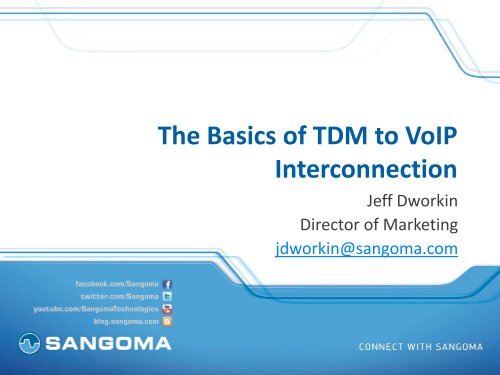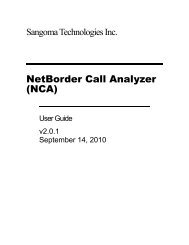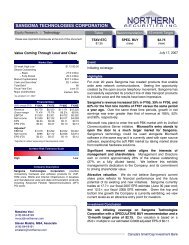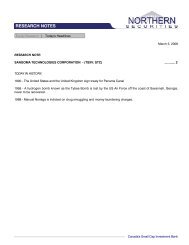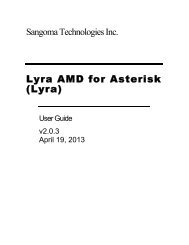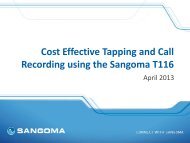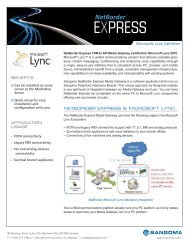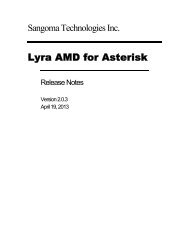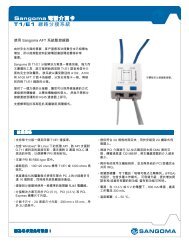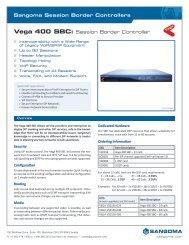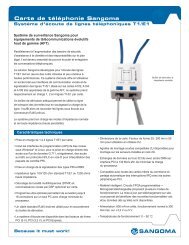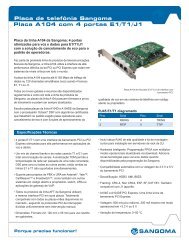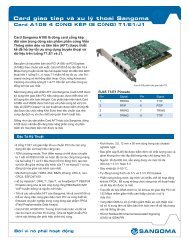Download presentation - Sangoma
Download presentation - Sangoma
Download presentation - Sangoma
You also want an ePaper? Increase the reach of your titles
YUMPU automatically turns print PDFs into web optimized ePapers that Google loves.
The Basics of TDM to VoIP<br />
Interconnection<br />
Jeff Dworkin<br />
Director of Marketing<br />
jdworkin@sangoma.com
Attendee Dashboard<br />
© <strong>Sangoma</strong> Technologies<br />
April 2013<br />
Control<br />
Panel<br />
•Click plus [+] icon to expand<br />
menus<br />
•Click minus [-] icon to collapse<br />
menus<br />
Questions<br />
Panel<br />
•Type and submit your questions in<br />
the Questions Pane<br />
•Located on the right hand side of<br />
your screen<br />
2
About <strong>Sangoma</strong><br />
© <strong>Sangoma</strong> Technologies<br />
April 2013<br />
• Industry pioneer with over 25 years of experience is<br />
communications hardware and software<br />
• Publicly traded company since 2000<br />
– TSXV: STC<br />
• One of the most financially healthy companies in our industry<br />
– Growing, Profitable, Cash on the Balance Sheet, No Debt<br />
• Mid-market sized firm with just under 100 staff in all global<br />
territories<br />
– Offices in Canada (Toronto), US (NJ), EU (UK & Holland), APAC (India),<br />
CALA (Miami)<br />
• World Wide Customer base<br />
– Selling direct to Carriers and OEMs<br />
– Selling to the Enterprise through a network of distribution partners<br />
3
Broad Line of Great Products<br />
© <strong>Sangoma</strong> Technologies<br />
April 2013<br />
• Voice Telephony Boards<br />
– Analog/digital/hybrid, WAN, ADSL<br />
• Software Applications<br />
– NetBorder Express<br />
– Call Progress Analyzer<br />
– Lyra AMD for Asterisk<br />
• VoIP Gateways<br />
– SIP-to-TDM<br />
– TDM-to-SIP<br />
– SS7-to-SIP<br />
• Session Border Controllers<br />
• Microsoft Lync<br />
• Wireless Products<br />
• Cloud based monitoring<br />
• Fiber connectivity (STM1)<br />
• Transcoding (boards/appliances)<br />
4
Vibrant Ecosystem of Clients & Partners<br />
© <strong>Sangoma</strong> Technologies<br />
April 2013<br />
Open Source Telephony<br />
Ready to use drivers for <strong>Sangoma</strong> boards<br />
Proprietary PBX and IVR<br />
Plug-in to major soft-PBX and IVRs<br />
Contact Center<br />
OEM Integration with major software suites<br />
Carriers, Cloud, Data Ntwks<br />
Proven Infrastructure Technology<br />
5
Innovation and Interoperability<br />
© <strong>Sangoma</strong> Technologies<br />
April 2013<br />
Indian Army<br />
6
Key Points of this Presentation<br />
© <strong>Sangoma</strong> Technologies<br />
April 2013<br />
• Common issues in IP-to-TDM and IP-to-IP<br />
interconnections, and mitigation strategies to<br />
address them<br />
• Key technology solutions to bridge disparate<br />
networking technologies and applications<br />
common today and coming in the future<br />
• A practical migration strategy to seamlessly and<br />
cost-effectively connect the service provider to<br />
the customer, even in the face of disparate<br />
technologies<br />
7
Challenges in a TDM-to-VoIP Migration<br />
© <strong>Sangoma</strong> Technologies<br />
April 2013<br />
• Service Provider View Point<br />
– Capital Expenditure<br />
– Learning Curve<br />
– Potential Service Disruption<br />
– Security<br />
• Customer View Point<br />
– Capital Expenditure<br />
– Learning Curve<br />
– Potential Service Disruption<br />
– Security<br />
8
Finger Pointing<br />
© <strong>Sangoma</strong> Technologies<br />
April 2013<br />
You Go First<br />
WE Go No Where<br />
No, you Go First<br />
NO! you Go First<br />
9
Disparate Technology Islands<br />
© <strong>Sangoma</strong> Technologies<br />
April 2013<br />
THE REST OF THE WORLD’S<br />
TDM NETWORK<br />
Customer’s<br />
IP<br />
Network<br />
Carrier<br />
IP<br />
Network<br />
THE REST OF THE WORLD’S<br />
IP NETWORK<br />
Carrier<br />
TDM<br />
Network<br />
Customer’s<br />
TDM<br />
Network<br />
10
All IP Doesn’t Solve All Issues<br />
© <strong>Sangoma</strong> Technologies<br />
April 2013<br />
Your<br />
IP<br />
Network<br />
THE REST OF THE WORLD’S<br />
IP NETWORK<br />
Customer’s<br />
IP<br />
Network<br />
11
SIP Interop Challenges<br />
© <strong>Sangoma</strong> Technologies<br />
April 2013<br />
• SIP (RFC3261) and Interoperability challenges<br />
– Largest RFC<br />
– Not a ‘super tight’ spec:<br />
• Should: 344 times<br />
• Can: 475 times<br />
• May 381 times<br />
• Option: 144 times<br />
– Lots of room for interpretation<br />
– SIP Endpoints end up with slight differences that make<br />
it hard to interconnect<br />
• End point could use different codecs<br />
12
LOOKING AT<br />
THE CUSTOMER PREMISE
Applications Enabled<br />
© <strong>Sangoma</strong> Technologies<br />
April 2013<br />
• SIP Trunking (SIP-SIP)<br />
• VoIP Enablement of Existing TDM Equipment<br />
(TDM-SIP)<br />
• Legacy Connectivity for the IP-PBX (SIP-TDM)<br />
• Connecting Legacy Equipment to an IP-PBX<br />
14
Over The Top Services<br />
© <strong>Sangoma</strong> Technologies<br />
April 2013<br />
• SIP and Other VoIP Services Can Be Delivered<br />
Two Ways<br />
– Dedicated Facility<br />
• Broadband and SIP Delivered By Single Entity<br />
– Over The Top<br />
• Broadband and SIP Delivered By Different Providers<br />
15
SIP TRUNKING
Defining SIP Trunking<br />
© <strong>Sangoma</strong> Technologies<br />
April 2013<br />
• “The use of SIP service bundled in a familiar business<br />
construct to connect a PBX or gateway to the PSTN<br />
over the Internet”<br />
• An alternative to T1s, PRIs, and POTS lines<br />
• Pure SIP will allow you to make and receive calls<br />
worldwide and should include:<br />
– E911<br />
– Directory Assistance<br />
– CNAM (Caller ID/Name)<br />
17
SIP Trunking Diagram<br />
© <strong>Sangoma</strong> Technologies<br />
April 2013<br />
Demarc<br />
LAN<br />
SBC<br />
WAN<br />
IP<br />
Network<br />
IP PBX<br />
IP Router<br />
RTP<br />
SRTP<br />
SIP / UDP<br />
SIP / TLS<br />
• SBC used to provide security between the two IP<br />
Networks<br />
• May also handle signaling interoperability<br />
• May also handle basic transcoding<br />
• Connection from PBX could be digital or analog<br />
18
SIP Trunking Benefits<br />
© <strong>Sangoma</strong> Technologies<br />
April 2013<br />
• SIP Trunking allows companies to replace<br />
physical PSTN trunks with virtual, broadband<br />
trunks, deployed over data connections<br />
• Can be<br />
– Dedicated lines or shared connections<br />
– Internet connections<br />
– Burstable<br />
• Introduces more flexibility, more efficiency,<br />
reduces operational costs<br />
19
VOIP ENABLEMENT OF EXISTING<br />
TDM EQUIPMENT
VoIP Enablement Diagram<br />
© <strong>Sangoma</strong> Technologies<br />
April 2013<br />
PBX<br />
phones<br />
Legacy PBX<br />
E1T1<br />
VoIP Gateway<br />
LAN<br />
IP Router<br />
IP<br />
Network<br />
Demarc<br />
• Gateway used to enable SIP service on legacy<br />
PBX<br />
• Connection from PBX could be digital or<br />
analog<br />
21
VoIP Enablement Benefits<br />
© <strong>Sangoma</strong> Technologies<br />
April 2013<br />
• Enables Service Provider to retain customers who have<br />
moved not yet moved to an IP Infrastructure<br />
• Mitigates the threat of encroachment of the Over-The-<br />
Top SIP Provider in the Future<br />
• All Integration takes place at the customer premise.<br />
No need to change Service Provider network,<br />
equipment or operations.<br />
• Allows customer to take advantage of cost savings and<br />
additional flexibility while still leveraging their existing<br />
investment in their legacy PBX<br />
22
LEGACY CONNECTIVITY FOR IP-PBX
VoIP Legacy Connectivity<br />
© <strong>Sangoma</strong> Technologies<br />
April 2013<br />
• Service Provider Delivers TDM<br />
• IP-PBX or Other VoIP Services at Premise<br />
LAN<br />
VoIP Gateway<br />
E1T1<br />
PSTN<br />
Network<br />
IP PBX<br />
Demarc<br />
24
Legacy Connectivity Benefits<br />
© <strong>Sangoma</strong> Technologies<br />
April 2013<br />
Carrier Benefits<br />
• Enables Service Provider to<br />
retain customers who have<br />
moved to VoIP before the<br />
Service Provider is Prepared<br />
• Mitigates the threat of<br />
encroachment of the Over-<br />
The-Top SIP Provider<br />
• All Integration takes place at<br />
the customer premise. No<br />
need to change Service<br />
Provider network, equipment<br />
or operations.<br />
Customer Benefits<br />
• No issues with 911 or other<br />
emergency services at<br />
customer premise<br />
• Maintain connectivity even<br />
in the event of an Internet<br />
or WAN failure<br />
• Alarm systems, fax<br />
machines, etc. can still be<br />
connected directly to the<br />
legacy PSTN connections<br />
25
CONNECTING LEGACY EQUIPMENT<br />
TO AN IP NETWORK
Legacy Gear Connectivity<br />
© <strong>Sangoma</strong> Technologies<br />
April 2013<br />
• FXS Devices look like IP Devices to the IP-PBX<br />
IP-PBX<br />
PSTN<br />
Analog<br />
BRI<br />
PRI<br />
SIP/VoIP<br />
SIP/VoIP<br />
LAN<br />
FXS FXS FXS<br />
IP Phones<br />
Analog endpoints<br />
27
© <strong>Sangoma</strong> Technologies<br />
April 2013<br />
Legacy Gear Connectivity Benefits<br />
• No need to redevelop TDM-based systems<br />
(IVR/Contact Center) before moving to an IP<br />
Communications Platform<br />
• Preserve investment in endpoints and<br />
structured wiring<br />
28
LOOKING AT<br />
CARRIER-TO-CARRIER CONNECTIVITY
Technology Touch Points<br />
© <strong>Sangoma</strong> Technologies<br />
April 2013<br />
• Extending investments in TDM equipment<br />
• Accessing SS7 from the VoIP Network<br />
• Managing Codec Requirements when<br />
integrating with other Providers<br />
• Network Security in an all IP Environment<br />
30
SS7 GATEWAY
SS7 Explained<br />
© <strong>Sangoma</strong> Technologies<br />
April 2013<br />
• Signalling System number 7 (SS7) is a legacy PSTN protocol that is in<br />
use in carrier networks<br />
• Some markets use SS7 to connect to large enterprises (such as a call<br />
center)<br />
• It is a very vast protocol set<br />
– It is the base for the PTSN<br />
– All GSM networks run on SS7<br />
• Network Nodes are identified with Point Codes<br />
• SS7 protocol has several layers<br />
– MTP 1, 2, 3 for routing messages<br />
– ISUP for call set-up<br />
– TCAP for transactions<br />
(800, CNAM, LNP)<br />
TCAP<br />
SCCP<br />
MTP3<br />
ISUP<br />
MTP2<br />
MTP1<br />
32
SS7 VoIP Gateway Components<br />
© <strong>Sangoma</strong> Technologies<br />
April 2013<br />
• As networks are moving to VoIP, there is a need for Media<br />
Gateways to convert PSTN Media and Protocols to IP based Media<br />
and Protocols<br />
• An SS7 Media Gateway needs<br />
– Telecom Interface (typically T1/E1)<br />
– IP Network Interface (typically Ethernet)<br />
– Protocol interpreters (or stacks) – SS7 ISUP/SIP<br />
– Lots of software to transform and translate how things are done on<br />
each side of the gateway<br />
SS7 over T1/E1<br />
Channelized, TDM voice<br />
on T1/E1<br />
TDM<br />
I/F<br />
SS7 to VoIP Gateway<br />
IP I/F<br />
SIP on IP Network<br />
RTP (Packetized Voice)<br />
on IP Network<br />
33
TRANSCODING
Audio Codecs<br />
© <strong>Sangoma</strong> Technologies<br />
April 2013<br />
• Codecs encode and decode voice for network transmission<br />
• Sampling rate: Number of samples per seconds<br />
– The higher rate the better the quality<br />
• Quantization: Granularity of the representative data<br />
– The more granularity the better the quality<br />
• Bit rate = [Sampling rate] X [Quantization bits]<br />
– The more quality is desired, the highest the bit rate will be<br />
• Sampling time: How long do I collect samples before “feeding” the<br />
algorithm<br />
– 10 ms, 20 ms, 30 ms, etc.<br />
• Algorithm is the core of the codec<br />
– Compression formulas<br />
– It’s is digital signal processing and a lot of math<br />
35
Sample Audio Codecs<br />
© <strong>Sangoma</strong> Technologies<br />
April 2013<br />
• G.711 (PCMU/PCMA, mu-law / A-law) – Narrowband<br />
– Sampling rate: 8 KHz (8000 times per second)<br />
– Bit Rate: 64 Kbps<br />
– Sample Time: 10ms, 20ms, 30ms, 40ms, etc.<br />
• G.722 – Wideband<br />
– Sampling rate: 16 KHz (16000 times per second)<br />
– Bit Rate: 48kbps, 56kbps and 64kbps<br />
– Sample Time: 10ms, 20ms, 30ms, 40ms, etc.<br />
• G.722.1 Annex C – Ultra-wideband<br />
– Sampling Rate: 32 KHz (32000 times per second)<br />
– Bit Rate: 48kbps<br />
– Sample Time: 20ms, 40ms, 60ms<br />
36
© <strong>Sangoma</strong> Technologies<br />
April 2013<br />
Need for Transcoding Servers/Proxy<br />
• I have a call for you<br />
• What do you<br />
support?<br />
2<br />
• OK. I will broker<br />
the call on both<br />
ends<br />
4<br />
• I’m calling the<br />
phone on the<br />
other side<br />
• I can do G.711<br />
1<br />
SIP<br />
SIP<br />
• I can do G.729<br />
3<br />
37
POLL QUESTIONS
SESSION BORDER CONTROLLER
Benefits of Deploying an Enterprise SBC<br />
© <strong>Sangoma</strong> Technologies<br />
April 2013<br />
• Network Security<br />
– Toll Fraud Protection<br />
– Protection against Denial of<br />
Service (DoS) attacks<br />
– Topology Hiding<br />
– Encrypting signaling and<br />
media (SIP/TLS & SRTP)<br />
• Connectivity<br />
– NAT Traversal<br />
– IPv4 to IPv6 Interworking<br />
– Protocol Normalization (SIP-<br />
SIP, SIP-H.323)<br />
• QoS/QoE<br />
– Quality of Service<br />
– Quality of Experience<br />
• Media Services<br />
– Transcoding<br />
– DTMF Interworking<br />
– Call Recording<br />
• BSS Support<br />
– Billing<br />
– Logging<br />
– Statistics<br />
• Regulatory Compliance<br />
– Lawful Intercept<br />
40
Enterprise Security Threats<br />
© <strong>Sangoma</strong> Technologies<br />
April 2013<br />
• Denial of Services<br />
– Call/registration overload<br />
– Malformed messages (fuzzing)<br />
• Configuration errors<br />
– Mis-configured devices<br />
– Operator and application errors<br />
• Theft of service/Fraud<br />
– Unauthorized users<br />
– Unauthorized media types<br />
• BYOD<br />
– Smartphones running unauthorized apps<br />
– Viruses and Malware attacking your VoIP network<br />
41
Service Provider/Carrier Security Threats<br />
© <strong>Sangoma</strong> Technologies<br />
April 2013<br />
• Denial of Services<br />
– Call/registration overload<br />
– Malformed messages (fuzzing)<br />
• Configuration errors<br />
– Misconfigured devices<br />
– Operator and application errors<br />
• Theft of service/Fraud<br />
– Unauthorized users<br />
– Unauthorized media types<br />
42
Typical VoIP Service Provider Network<br />
© <strong>Sangoma</strong> Technologies<br />
April 2013<br />
ITSP<br />
<strong>Sangoma</strong><br />
NetBorder Transcoding Gateway<br />
Softswitch<br />
CPE<br />
Broadband<br />
Router<br />
VoIP<br />
Vega SBC<br />
<strong>Sangoma</strong><br />
NetBorder SS7 to VoIP<br />
VoIP<br />
IP PBX<br />
PSTN<br />
SS7<br />
Voice<br />
VoIP<br />
IP<br />
Network<br />
VoIP<br />
Vega SBC<br />
ITSP<br />
VoIP Peering<br />
NetBorder SBC<br />
VoIP<br />
Vega GW<br />
Legacy<br />
PBX<br />
43
Conclusions<br />
© <strong>Sangoma</strong> Technologies<br />
April 2013<br />
• Both the carrier and the enterprise share common goals in<br />
migrating from TDM-to-IP<br />
• “Integration at the Edge” can enable TDM-To-IP migration<br />
incrementally, preserving capital and resources while<br />
delivering advanced functionality to your user base.<br />
• <strong>Sangoma</strong> can be your partner in managing this transition for<br />
you or your customers<br />
44
Upcoming Webinars<br />
© <strong>Sangoma</strong> Technologies<br />
April 2013<br />
<strong>Sangoma</strong> Education Series:<br />
• Cost Effective Tapping and Call Recording using the<br />
<strong>Sangoma</strong> T116<br />
– April 22, 2013 @ 11:00am EST<br />
• The SBC – The Critical Component<br />
– May 16, 2013 @ 2:00pm EST<br />
• Adding Telephony to Microsoft Lync with Office 365<br />
and Other Use Cases<br />
– June 11, 2013 @ 2:00pm EST<br />
Visit the <strong>Sangoma</strong> Training Page for more info. at:<br />
http://www.sangoma.com/resources/training/<br />
45
THANK YOU


